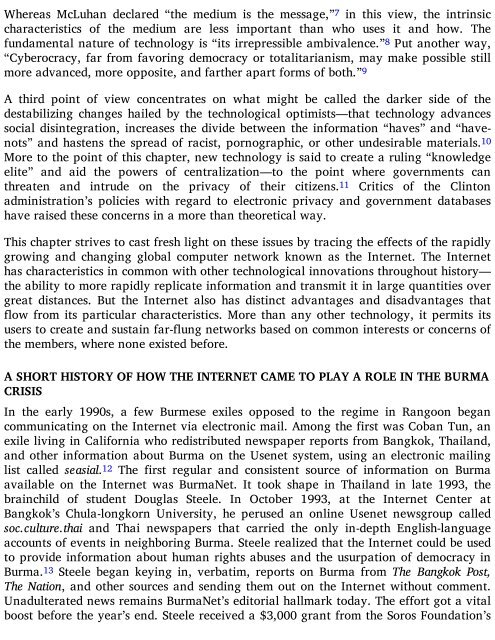RAND_MR1382
Create successful ePaper yourself
Turn your PDF publications into a flip-book with our unique Google optimized e-Paper software.
Whereas McLuhan declared “the medium is the message,” 7 in this view, the intrinsic<br />
characteristics of the medium are less important than who uses it and how. The<br />
fundamental nature of technology is “its irrepressible ambivalence.” 8 Put another way,<br />
“Cyberocracy, far from favoring democracy or totalitarianism, may make possible still<br />
more advanced, more opposite, and farther apart forms of both.” 9<br />
A third point of view concentrates on what might be called the darker side of the<br />
destabilizing changes hailed by the technological optimists—that technology advances<br />
social disintegration, increases the divide between the information “haves” and “havenots”<br />
and hastens the spread of racist, pornographic, or other undesirable materials. 10<br />
More to the point of this chapter, new technology is said to create a ruling “knowledge<br />
elite” and aid the powers of centralization—to the point where governments can<br />
threaten and intrude on the privacy of their citizens. 11 Critics of the Clinton<br />
administration’s policies with regard to electronic privacy and government databases<br />
have raised these concerns in a more than theoretical way.<br />
This chapter strives to cast fresh light on these issues by tracing the effects of the rapidly<br />
growing and changing global computer network known as the Internet. The Internet<br />
has characteristics in common with other technological innovations throughout history—<br />
the ability to more rapidly replicate information and transmit it in large quantities over<br />
great distances. But the Internet also has distinct advantages and disadvantages that<br />
flow from its particular characteristics. More than any other technology, it permits its<br />
users to create and sustain far-flung networks based on common interests or concerns of<br />
the members, where none existed before.<br />
A SHORT HISTORY OF HOW THE INTERNET CAME TO PLAY A ROLE IN THE BURMA<br />
CRISIS<br />
In the early 1990s, a few Burmese exiles opposed to the regime in Rangoon began<br />
communicating on the Internet via electronic mail. Among the first was Coban Tun, an<br />
exile living in California who redistributed newspaper reports from Bangkok, Thailand,<br />
and other information about Burma on the Usenet system, using an electronic mailing<br />
list called seasial. 12 The first regular and consistent source of information on Burma<br />
available on the Internet was BurmaNet. It took shape in Thailand in late 1993, the<br />
brainchild of student Douglas Steele. In October 1993, at the Internet Center at<br />
Bangkok’s Chula-longkorn University, he perused an online Usenet newsgroup called<br />
soc.culture.thai and Thai newspapers that carried the only in-depth English-language<br />
accounts of events in neighboring Burma. Steele realized that the Internet could be used<br />
to provide information about human rights abuses and the usurpation of democracy in<br />
Burma. 13 Steele began keying in, verbatim, reports on Burma from The Bangkok Post,<br />
The Nation, and other sources and sending them out on the Internet without comment.<br />
Unadulterated news remains BurmaNet’s editorial hallmark today. The effort got a vital<br />
boost before the year’s end. Steele received a $3,000 grant from the Soros Foundation’s










![Genki - An Integrated Course in Elementary Japanese II [Second Edition] (2011), WITH PDF BOOKMARKS!](https://img.yumpu.com/58322134/1/180x260/genki-an-integrated-course-in-elementary-japanese-ii-second-edition-2011-with-pdf-bookmarks.jpg?quality=85)
![Genki - An Integrated Course in Elementary Japanese I [Second Edition] (2011), WITH PDF BOOKMARKS!](https://img.yumpu.com/58322120/1/182x260/genki-an-integrated-course-in-elementary-japanese-i-second-edition-2011-with-pdf-bookmarks.jpg?quality=85)





